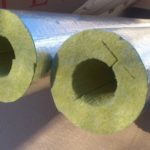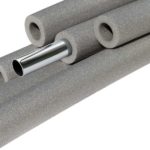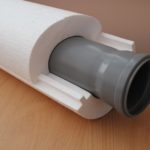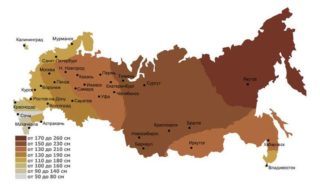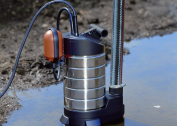The outer part of the water supply, subject to a shallow laying in the ground, requires mandatory insulation. Otherwise, there will be problems with supplying water in severe frosts. The system will just freeze. To maintain the efficiency of communication, you need high-quality insulation for water pipes. Materials for insulation differ in the type of packaging (rolls, plates, casings) and the main component from which they are made.
The importance of warming water pipes in the ground
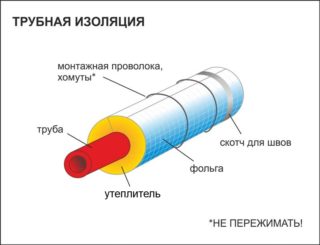 It is necessary to insulate the water supply system in such cases:
It is necessary to insulate the water supply system in such cases:
- laying pipes above the level of freezing due to the terrain on the site;
- year-round family residence in the house subject to surface laying system;
- living in cold-resistant regions, where the average temperature in winter and spring does not rise above -10 degrees - here the level of soil freezing reaches 2-2.5 meters, which makes the installation of a water supply system labor-intensive.
If you do not insulate the water supply system qualitatively in all its sections from the exit from the well / well to the pipe entrance to the house, in the best case the communication will simply freeze to the first thaw. In the worst case, the system tubes will burst. Then serious repairs in the spring can not be avoided, and this is an additional financial cost.
According to SNiP, all underground utilities must be laid below the level of soil freezing.
The basic principle of operation of all heaters is the creation of an air layer that retains heat. Therefore, all materials are classified as foamed.
Materials for thermal insulation
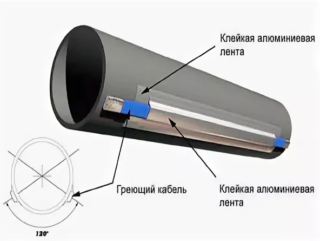 In order for the insulation of the water supply system to be of high quality, the materials used must meet the following requirements:
In order for the insulation of the water supply system to be of high quality, the materials used must meet the following requirements:
- good heat-saving ability and, accordingly, low thermal conductivity;
- durability;
- ability to remove moisture;
- inertness to chemical and biological environments, the development of microorganisms in them;
- ease of installation;
- favorable price for the family budget.
The materials presented on the modern market largely meet these characteristics. The following heaters are considered the most popular:
- Glass wool. The most budget and options. It has low weight and good thermal insulation ability. However, the material is hygroscopic - it actively absorbs condensation and moisture. To protect the pipes from water, you will have to additionally lay a waterproofing layer on top and bottom of the glass wool. This leads to additional costs. Mostly glass wool is used on plastic HDPE pipes. Popular materials are brands Knauf, Ursa, Isover.
- Polyfoam (expanded polystyrene). Lightweight, strong, durable material. It retains heat perfectly and does not absorb moisture. For the convenience of users, the manufacturer offers ready-made half-cylinders of the desired section for insulation of water pipes. It remains only to lay pipes in them and fix with tape. In some cases, an additional protective coating of foil or polymer is provided in the foam shell.
- Foamed polyethylene (polyethylene foam). Relatively recently tested and trustworthy material. It reacts calmly to temperature fluctuations, does not absorb moisture and retains heat well. Serves an average of 25-50 years. Prices per meter of insulation for water pipes in the ground are quite reasonable, start from 28 rubles. The material is produced in the form of a casing for a pipe or in the form of half-cylinders. It is important to consider that foamed polyethylene sags under soil pressure, which makes it lose its ability to store heat.Most often, such a heater is used for surface laying of pipes or for the inside of a water supply system.
- Heat-insulating paint. Novelty in the field of pipeline insulation. The coloring composition is applied to the pipe. A layer thickness of 4 mm will fully replace the mineral wool insulation of 8 mm. However, the cost of such material is approximately 150 cu for 10 liters.
- Power cable. Allows you to warm the pipeline in extreme cold. It is wound along the surface of the system with an equal pitch of a turn. Using a heating cable, it is possible to give heat to pipes laid 1 m above the ground. The average energy consumption is 20 W / linear meter. The cable can be laid both outside the system and inside. In the first case, the master will cope on his own, but most of the heat will go into the external environment. In the second option, you need to invite specialists. Apply power to the power cable only at sub-zero temperatures.
- Glass wool
- Polyethylene foam
- Polyfoam for sound insulation of pipes
As an alternative way to warm the water main, use the creation of an air gap. Corrugated elements are put on the tubes, the cross section of which exceeds the diameter of the water supply. The result is an air gap, which is a heater. When water moves in the pipes, a kind of heating forms.
If the system is not used for 1-2 days, the effect of air insulation disappears on its own due to the lack of hydraulics in the pipeline.
Methods of pipe insulation underground
To ensure the heating of the outer part of the water supply, the masters resort to such methods of insulation:
- laying a water supply system below the level of soil freezing by 0.5 m;
- insulation with polystyrene shells and other heat insulators;
- laying of a heating cable;
- installation of the system from ready-made insulated pipes (they are one tube in another - larger with a heater laid between them);
- air gap;
- a combination of several ways.
As a rule, several warming options are combined, because part of the water entering the house or leaving the well / well is in different temperature conditions.
Cost of insulation
Prices for thermal insulation materials diverge depending on their shape, main component and thickness / diameter. Average prices in Moscow:
| Name of insulation | Manufacturer | Price, rub.) |
| The made foam polyethylene (pipes 2 m) Energofleks | Russia | From 14 rub./m. linear depending on the diameter |
| Thermoflex foam (pipe) | Netherlands | From 7 rub./m. linear depending on diameter and thickness |
| Mineral / basalt wool cylinder, uncut | Russia | From 102 rubles / m. |
| Styrofoam shell (polystyrene) | Russia | From 120 rubles / m. |
| Power cable (7 m): Grand Meyer | Netherlands | 1 920 rub. per skein. |
It is necessary to insulate all sections of the pipeline that are in the cold, including in unheated basements. It is forbidden to leave the slightest gaps between the material. When carrying out construction work, it is advisable to prepare a scheme on which the entire length of the water supply is marked.
To protect the insulation from the attack of rodents who want to warm themselves in the winter on the line, it is better to wrap the pipes additionally with a metal mesh or cover with a layer of plaster with broken glass added to it.
